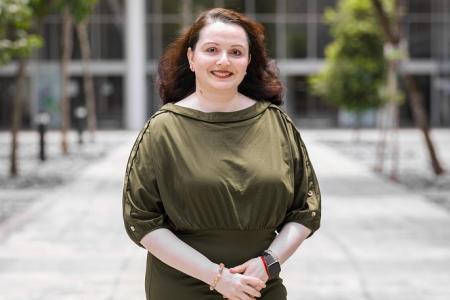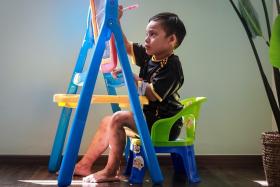Vitiligo patients in Singapore cope with skin disorder
Senior lecturer Malini Thyagesan used to dislike having her photograph taken and would be upset when people pulled their children away from her.
But she has now come to accept her skin condition, called vitiligo.
Vitiligo is an autoimmune disorder in which the body’s immune system attacks skin pigment cells, turning a person’s skin white due to the loss of pigment, or melanin.
The incurable condition is hereditary but may skip generations, can affect any age group and can flare up due to stress, trauma and injury to the skin. It is not contagious.
Those afflicted, like Ms Malini, often experience self-esteem issues at the onset of the condition. But some have learnt to accept it.
Ms Malini was eight years old when she first noticed that something was not right after a tree branch hit her eye. The accident left a white patch on her eyelid.
Her parents, neither of whom has any family history of the condition, dismissed it as a healing wound.
But six years later, as 20 per cent of her body became covered in white patches, her parents took her to see a dermatologist.
“I could still cover them up by wearing long sleeves or heavy make-up. But there was always one thing that was constantly ringing in my head when I looked in the mirror: Ugly, ugly, ugly,” the 44-year-old, who teaches at Republic Polytechnic’s School of Applied Science, told The Straits Times.
Ms Malini resorted to using topical steroid cream to tame the pale patches, but more patches appeared. Frustrated, she decided at age 16 to forgo any sort of treatment altogether.
Dr Goh Boon Kee, a dermatologist at Skin Physicians in Mount Elizabeth Medical Centre, who sees about 100 vitiligo patients a month, said that the common concern among patients is their appearance, especially when the white patches appear on exposed parts of their body like the face and limbs.
The National Skin Centre did not respond to ST’s queries regarding what proportion of Singaporeans suffer from vitiligo and how many seek treatment for their condition, although researchers estimate that it affects around 1 per cent of the world’s population.
Notable vitiligo sufferers include American pop star Michael Jackson, Bollywood actor Amitabh Bachchan and fashion model Winnie Harlow, but the condition is still not widely understood.
Ms Malini said that people often think she had suffered serious burns, “or worse, that I have a contagious disease”, she said with a laugh. She has discovered that using Jackson as a reference when explaining her condition to others helps.
The King of Pop, an African American who died in 2009 at age 50, was diagnosed with vitiligo when he was 24, and faced countless accusations of bleaching his skin to appear white. By the time he was 31, his most of his skin had lost its pigment.
Ms Malini slowly grew more confident in her own skin – patches and all – thanks to support from her teachers and being treated “normally” by her friends. She was even asked to emcee at school events, and joined school debate competitions, which sparked her interest in public speaking.
But there are still moments when she feels ostracised. She recalled occasions when curious children stared at her before they were pulled away by their parents.
“I get that kids are kids, but I wish the adults would educate their child on why I look like that, instead of turning them away,” Ms Malini said.
Vitiligo has no cure, said Dr Goh, adding that there are three different approaches to treating the condition – by stopping it from spreading, repigmentation or camouflage.
To stop the spread of vitiligo, he said, oral steroids and steroid creams can be used, while phototherapy – exposure to light at controlled wavelengths – may help restore skin colour.
“For patients whose vitiligo is stable and who fail to respond adequately to (those) treatments, surgical grafting can be considered,” said Dr Goh. “This involves transplanting the patient’s normal skin or skin cells onto the vitiligo areas to replenish the lost pigment cells.”
Mr Terrance Wong Siew Cheng, 27, underwent a grafting procedure in 2023, two years after he first noticed signs of vitiligo.
He initially tried to cover the patches on his face and neck with make-up, and then used steroid creams. Both proved unsuccessful.
He then resorted to phototherapy, but being of fairer complexion, he noticed that it was making his patches darker than the rest of his body.
Finally, he found out he was eligible for surgical grafting.
“The skin was taken from my outer thigh and was a very painful process,” said Mr Wong, who is unemployed.
“But the procedure made my skin go back to normal. I no longer have any more patches, except for some tiny bits around my eye area. But it’s not so visible, and the (skin in that) area is too thin to do grafting.”
Like Mr Wong, 37-year-old Jaslyn Ong discovered that she had vitiligo only as an adult.
An educator, Ms Ong said she was 33 when she noticed a white patch the size of a 50-cent coin on her arm. The whiteness later spread to her hands and feet.
Her self-esteem took a hit, and for a while she turned to make-up and concealers to manage the condition. She later turned to regular medical treatment to stabilise the spots.
But she adopted a positive outlook about her situation.
She is thankful her three young children – aged five, eight and 10 – have shown no signs of vitiligo but is aware that even if they do not develop it, their offspring might.
“But I hope to reassure them that vitiligo is not life-threatening and that it can be managed with medical treatment,” said Ms Ong.
Talking openly about living with vitiligo – and enlightening others – have helped those afflicted with it cope better with their situation.
For example, when Ms Malini enrolled at the National Institute of Education at age 22 to be a teacher, she was told to expect that students would inevitably stare at her and some might say something offensive.
So, on her first day as a teacher, as she introduced herself to her students, who ranged from 13 to 17 years old, she explained vitiligo to them and encouraged them to ask questions.
Her direct approach made her students feel comfortable and eager to learn about her condition, she said, adding that they told her they initially wanted to ask questions about her skin but did not want to offend her.
Ms Malini, who has two daughters, aged eight and 15, said before she got married in 2008, she feared that the genetic condition may be passed down to her children. But she overcame her concern with her husband’s support.
She recalled that when they were dating, he said: “Which girl stays the same forever? A relationship is beyond appearances.” That sealed the deal for her and they got married.
Now, with her skin about 98 per cent white, Ms Malini calls herself the “unofficial one-man support group” for people with vitiligo – she has advised and counselled friends of friends who also have the condition – and hopes to start a proper support group one day.
But as much as she has grown to embrace her skin, she continues to have days when she struggles with her appearance. Yet she knows it has also shaped the person she has become.
“If someone compliments me or says something like ‘You’re so fair!’, I feel like saying, ‘This is not the real me. I am not supposed to look like this. I am supposed to be brown,’” said Ms Malini.
“I used to ask ‘why me?’ when I was younger, but looking back now, I thank the universe that it was me and for my experiences. I wouldn’t be who I am today without it all.”
Get The New Paper on your phone with the free TNP app. Download from the Apple App Store or Google Play Store now


